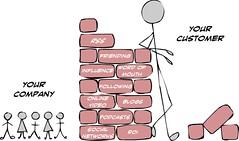In the weeks since Facebook’s IPO, the Zuckerberg-lead social network has been under intense scrutiny, with many expressing doubts as to the financial viability of Facebook’s revenue model, especially with regard to its advertising service. GM pulled their Facebook marketing campaign, and music industry e-commerce startup Limited Run made an impact with their claim that 80% of the clicks for their Facebook ads were made by bots (although the jury is still out on the accuracy of that complaint). A study from the Advertising Research Council claimed that “blank” ads with no content were performing only 0.1% less well than regular ads.
While this news is not good for Facebook’s future revenue, and businesses should think hard before spending their advertising budgets on Facebook’s paid ad platform, the real value of Facebook and social media generally was never through paid ads anyway. The true virtue of social media is not that it increases short-term conversion rates, but that it allows brands to build engagement and foster a community that can have a significant impact on revenue over the medium and long term. In this area, the future of Facebook is much more robust, and the indications are that social media proper, rather than paid ads on social media, are an excellent target for marketers.
Author Archives: Daniel Page
What is Content Marketing?
It’s becoming increasingly clear that traditional advertising is not creating the levels of engagement that marketers might hope for. Consumers are conditioned to barely see banner advertising — assuming they haven’t installed an ad-blocker — and they are very sensitive and averse to content which they perceive to be biased towards selling. Content marketing is an alternative or complementary marketing method that aims to generate conversions in the long term by fostering brand loyalty and awareness, and demonstrating competence within a particular niche.
Content marketing is simply providing content, be it text, audio, video, or even apps, that is of value to clients and customers. Content marketing makes businesses into publishers. This blog post is an example of content marketing.
Google’s June/July Algorithm Updates
Google didn’t release their usual algorithm update news last month, so this week we have a plethora of juicy updates to look at. As with the trend in recent months, Google have been concentrating on tidying up the SERP page, improving their detection of high-quality content (Panda), and enabling better information to be made available on the search page rather than having to click through to the results.
Results Page Changes
Clustering
One of the bugbears that’s been bothering the SEO community in recent weeks has been the way that many of the top results for searches have been from the same domains. In the worst cases, a search can result in almost all the results being from the same site. Google have made three improvements to their site clustering algorithms to hopefully improve the diversity of search results.
See What Googlebot Sees: Fetch As Google.
A couple of weeks ago we looked at negative SEO and what you can do to protect your site. One of the techniques we mentioned was hacking. Competitors, upon gaining access to a site, may alter the content or add malware to pages in the hope that Google will delist or penalize a site. Hackers may also simply attempt to use a site to spread their malware without any particular intentions regarding SEO.
We gave a number of suggestions for dealing such an intrusion, but often, after having received a warning from Google, it can be difficult to determine exactly what the Googlebot crawler is seeing. Hackers are adept at making a site appear perfectly normal to those who go directly to a page, while serving malware or undesirable keywords and hidden links to search engine crawlers and those who arrive at a site from a search engine. What you see when you visit a site is not necessarily what Googlebot is seeing.
Social Proof Works: Here’s Why.
One of the major psychological foundations for the purported effectiveness of social media marketing is social proof. The idea is fairly simple: people are more likely to find a product or service appealing if there is evidence that other people find it desirable. Robert B. Cialdini, in his very popular Influence: Science and Practice, describes social proof as
an important means that people use to decide what to believe or how to act in a situation by looking at what other people are believing or doing.
We’re social animals, and signals from our peers as to the desirability of particular objects has a significant influence on whether we want them too. In social networking, this principle is put into practice through the pursuit of “likes” or “+1s”, and through an active pursuit of conspicuous evidence of engagement and approval for products and brands among consumers.
Ranking Plunged For No Apparent Reason? Are You The Victim of Negative SEO?
In a recent blog entry, Matt Cutts discusses a common response of sites that have been delisted or had their SERP position drop. Webmasters say that there’s nothing wrong with their site, that they haven’t been engaged in any shady link-building strategies, and Google is unfairly punishing them. Cutts responds that in many of these cases the reason for the penalty is that sites have been hacked and infected with malicious software without webmaster being aware.
Hacking a site is one of a number of Negative SEO strategies that a site’s competitors can engage in to damage search rankings and reputations. Today we’ll be having a look at hacking and a couple of other Negative SEO tactics, so that you can be aware of possible vectors of attack for your sites, and what you can do about them.
Continue reading
Why SEOs Shouldn’t Ignore The Small Players in Search
As we noted in our previous article, personalization in the major search engines is changing the SERP landscape. Indeed, each individual is getting a search landscape uniquely shaped to meet their needs. Google is spending incredible amounts of money on research and development in order to bring relevant search results to its users. They have more or less bet the farm on socially directed, personalized search results. Some people find this to be a wonderful advance, and Google’s recent iteration for search on mobile — Google Now — is the logical extension of this approach, and has found favor in many corners.
When Is Less Traffic a Good Thing?
Many sites around the web have taken a hit with their traffic numbers because of Google’s recent Panda and Penguin updates, and it would be hard to argue that this is in any way positive. But, if we put these causes for traffic loss aside, there is another factor that is of concern to SEOs and webmasters. Even if sites haven’t seen their traffic dip because of algorithm changes, Google’s recent drive to personalize search results has made it nigh on impossible to predict with any certainty what a particular user’s SERP is going to look like. All the SEO in the world isn’t going to help with driving traffic to a site if Google decides, based on their browsing, search, and social media data, that a particular user, in spite of entering apparently relevant search terms, is actually looking for something unrelated to your site.
However, in theory at least, personalization of SERP results is reducing traffic only by reducing false positives. By taking note of web history, search history, and social media signals, Google is attempting to reduce the ambiguity of search keywords and refer only those visitors who are actually going to be interested in the content of a particular site. This means that even though overall traffic is reduced, conversions rates will remain steady, or even rise as a percentage of visits.
Are Social Signals the New Links? In Short: No.
Ever since Eric Schmidt confirmed at LeWeb last year that social signals were being taken into consideration for SERPs, the SEO world has been rife with speculation and conjecture about the relative merits of social signals as compared to links. Some of the more excitable members of the industry even went so far as to declare the death of link-building as an SEO tool. In a recent interview, Google’s chief spam slayer, Matt Cutts, has attempted to dampen down the more extreme prognostications about the ascendency of social signals. Yes, social signals are being used to some extent, but the humble link still leads the way when it comes to determining SERP rankings, and it will for some years to come.
Four Ways to Ensure Your Site Gets Crawled Frequently
There’s nothing more frustrating for a webmaster than having to wait to be crawled. After you’ve perfected your on-site SEO, created some great content, and ensured you have a spider-friendly link structure, all you can do is sit back and wait for the search engine crawlers to come a-knocking. Google will crawl your site at a frequency it determines, and while you can use Google Webmaster Tools to set a crawl rate, that will just limit crawls to a rate below the one you specify to prevent your server from getting hammered. It won’t encourage Googlebot to pay a visit any more frequently if its algorithms decide that there is no need. There are, however, methods you can use to speed up the bots crawl rate, and today we’ll have a look at 4 of them.



